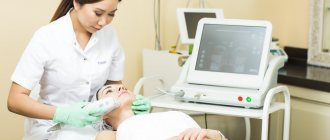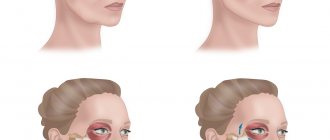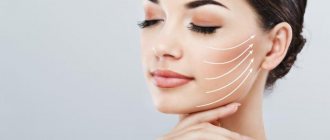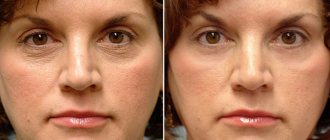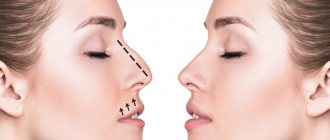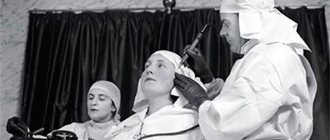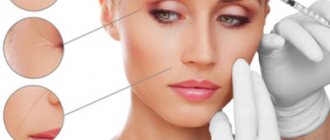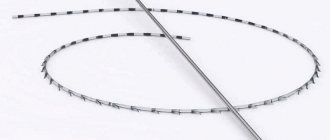- home
- Facial plastic surgery
- Plastic surgery, midface lift - indications and techniques
Facial aging depends on several factors: heredity, lifestyle (sleep, sun, cigarettes), self-care, general health, and also, to a large extent, weight stability. It is impossible to clearly determine when a patient will need facial plastic surgery. It makes no sense to focus on age in this matter, since the basis for the operation is objective medical indications and individual aesthetic requirements.
What is it and what are the pros and cons?
One of the popular procedures for getting rid of wrinkles is plastic surgery or lifting of the middle third of the face.
This is exactly the same area where everyone’s hated facial wrinkles are concentrated. This operation is classified as plastic. After its implementation, the clarity of the oval of the face returns, signs of aging are eliminated and the face looks younger. As with any type of surgery, a midface lift has its pros and cons.
pros:
- the operation is practically harmless;
- rehabilitation after surgery is quick;
- side effects are minimal;
- the effect of the procedure will please the patient for a long time.
The disadvantages are possible complications after the operation, some of them are inevitable - bruises and swelling at the site of the incisions, the appearance of pigmentation, you can only speed up the regeneration process with various ointments and compresses.
If the incision was in the area of hair growth, then partial hair loss in this area is possible. The situation can be corrected by removing the scar.
Some of the negative consequences can be avoided by choosing a reliable and experienced specialist who will not allow:
- infection;
- disturbances in facial expressions and symmetry after the procedure;
- formation of traces of intervention.
Kinds
An endoscopic midface lift can be performed in several ways, which are determined by the surgeon performing the procedure. Skin defects can be corrected using two methods:
- incisions near the lower ciliary edge with further excision of muscles and tension of dermal tissue;
- incisions near the ears and stretching of the skin through the oral mucosa, in which incisions are also made.
The second method of midface lift is safer because the muscles are not affected during the operation. Injuries are completely excluded, and there are almost no side effects.
A lift of the middle third of the face, performed through incisions near the eyes, is more dangerous, since it can lead to unpleasant consequences - asymmetry of the facial contour, disturbances in facial expressions, even displacement of dermal tissue.
Indications
The reason for performing midface plastic surgery is solely the desire for aesthetic changes in appearance. Most people after a certain age notice how their face and skin have changed, so surgery can be used if:
- there is a desire to have a brow lift;
- deep wrinkles have formed in the area of active facial expressions;
- due to age-related changes, the face has become “sullen”;
- the skin became flabby.
What it is?
While interacting with patients, I realized one thing. If people now know about such a concept as “lifting” and even have a vague idea, then people know practically nothing about zonal corrections.
Our face ages unevenly. Some parts are faster, others are slower.
The middle zone is the part of the face between the imaginary horizontal lines running at the level of the eyebrows and nostrils. At the same time, the nasolabial folds also belong to this zone.
This area is believed to be the first to change. Signs of aging can appear quite early. Therefore, correction is permissible from 35-40 years old.
There are various correction methods. But I want to talk about the most suitable one - endoscopic facelift.
This manipulation is considered minimally invasive, as it does not involve major surgical interventions. The surgeon makes minimal incisions - no more than 2 cm. There is no skin excision.
The doctor peels off sagging skin, shifts muscle tissue and removes fat. If necessary, redistributes the skin.
The operation is accompanied by minimal blood loss. By working in certain layers, the amount of bruising and swelling is minimized. The recovery period becomes significantly shorter.
The operation lasts from one and a half to three hours. Depending on the complexity, it can take place either under local anesthesia or general anesthesia.
Contraindications
You should avoid a midface lift if you have health problems that are not compatible with this procedure.
List of some ailments for which a facelift is prohibited:
- diabetes;
- poor blood clotting;
- any oncological manifestations;
- negative reaction of the body to anesthesia;
- heart problems;
- infection of the body.
No matter how strong the desire to eliminate deficiencies by resorting to a lift, having the listed health problems, it is prohibited to perform the operation.
How long do the results last?
The result is usually not even perceived as the result of the operation. People around him usually note that the patient looks cheerful or particularly well-rested, as if he had recently returned from vacation, without assuming that this is due to the operation.
The effect after the procedure is visible immediately, although its final version can be assessed after a few months, when the tissues adapt and swelling subsides.
Of course, over time, the effect of the operation will undergo changes due to the ongoing aging process and the influence of gravity. However, you will always look better than if you had not had the surgery. In 10 to 15 years, you may look the same as you did before surgery, but ultimately be younger than if you had not had it.
Types of operations and photos
A midface lift is performed in two ways: check lifting and endoscopic lifting. These two types of procedures are very similar and fall under the category of endoscopic surgeries, but there are several significant differences between them that affect the final result. There is also a photo before and after check-lifting and endoscopic surgery of the middle third of the face.
Endoscopic lifting
The essence of this operation is to redistribute the layers of dermis and muscles:
- An incision is made in the classic area - behind the ears, which, when stretched, eliminates wrinkles along the contour and cheekbones, but does not greatly smooth out the nasolabial folds. With this intervention, not the skin is removed, but only fat deposits. Oddly enough, this is enough for wrinkles to disappear and smooth out.
- Having fixed the skin and muscles in the new position, they are secured with self-absorbable threads.
Within a few months, the face fully adapts to the changes and you can forget about wrinkles for several years.
Check-lifting
Check-lifting is also carried out using endoscopic equipment and eliminates facial excision. It differs from an endoscopic lift by the location of the incision and, which, unlike an endoscopic lift, is made along the lower eyelid, in the area of growth of the lower eyelashes. A facelift is based on a vertical face lift, that is, sagging cheeks, eyelids, and eyebrows are lifted.
The effect of a vertical lift is higher, since there is no need to redistribute a large amount of skin. This technique allows you to combine rejuvenation of several areas of the face, but experts say that an integrated approach pays off to a greater extent.
Check lifting has the following advantages and disadvantages:
- easily and naturally combined with plastic surgery of the lower part of the face, since the latter is also carried out through incisions near the ear;
- less chance of damage to the nerve nodes located in the central part of the cheeks;
- lateral lifting is easier to perform, so there is less risk of errors;
- more incisions, since the path from the ear to the facial muscles is longer;
- The operation lasts longer - about 5 hours, and recovery, accordingly, takes longer - at least a month.
We invite you to watch a video about what a check-lift is:
How is it carried out?
A midface lift, like any surgical intervention, includes patient preparation, and the operation is carried out in several stages.
Preparation
There are no special requirements here, but you will have to pass a number of routine tests and undergo a medical examination. This helps avoid complications in the future. In addition, several days before the operation you will have to refrain from drinking alcohol and taking medications, and on the day of the lifting, drink less and not eat.
Carrying out the operation
In general, a facelift consists of several stages, which the doctor will always tell the patient about. First of all, general anesthesia is administered, then the skin is treated with antiseptics. After treatment, the surgeon uses a scalpel to make several incisions in those places that are carefully marked in advance. Excess tissue is excised through these holes and stretched.
The doctor also carries out redistribution and removal of the fat layer if necessary. This is followed by suturing and another antiseptic treatment, and the final stage is the application of a fixing bandage.
After surgery, patients remain in the hospital for several days. Doctors monitor your current state of health in order to provide timely assistance in the first days and prevent the occurrence of possible complications.
Rehabilitation
After a midface lift, the rehabilitation process lasts about 30 days, provided there are no complications and the patient follows all the doctor’s recommendations.
For the first seven days, be sure to wear a lightly compressive bandage to prevent the stitches from coming apart. It can be removed periodically to give the skin a rest. Washing your hair is allowed only after the next examination and permission from the doctor. Patients will be prescribed special medications to prevent serious swelling and bruising. Of course, you will have to deprive yourself of pleasure in the form of a bathhouse, sauna and solarium for at least a month. Also, do not engage in physical training or lifting heavy objects.
You will need to visit a doctor regularly so that he can assess the condition and monitor the healing process of the skin. If necessary, additional medications and procedures may be prescribed.
Preparation for the procedure
As with any planned surgical intervention, this procedure must be approached thoroughly and seriously. First of all, you need to consult in detail with a surgeon about contraindications, consequences and the characteristics of your body that can tolerate or even cancel the operation. After setting the date for the procedure and collecting the necessary tests, you need to follow the following preparation algorithm:
- 2 weeks before surgery, you must stop taking aspirin and aspirin-containing medications.
- Avoid drinking alcohol 3 days before surgery.
- Before arriving at the clinic, take a shower and be with the doctor on an empty stomach at the appointed time.
Possible complications
Any surgical intervention carries a certain risk of complications:
- Decreased sensitivity of facial skin - the patient feels numbness in certain areas. This feeling usually goes away on its own after a few weeks or months.
- Bruising and swelling, bleeding - occur more often in the first day after surgery. You need to see a doctor and he will help solve these problems.
- Damage to the nerves leads to facial asymmetry and distortion of facial expressions. Most often, physiotherapeutic action on the muscles is enough to eliminate this problem. But sometimes they resort to surgical restoration of the nerve.
- Inflammation - occurs more often in people with chronic diseases. The doctor will prescribe appropriate procedures and medications for treatment.
- Eversion of the century. Happens with improperly planned plastic surgery. It can be eliminated with blepharoplasty.
How the operation goes: step-by-step description of all stages
The procedure for an endoscopic lift looks like this::
- Anesthesia. Internal/combined anesthesia is used.
- Making cuts on the skin. There will be several of them, and their location is determined by the facelift area (temporal area, behind the ear area, inner side of the upper lip, etc.).
- Inserting the endoscope into the formed hole and slowly moving it towards the working area. The operator contemplates the resulting picture on the monitor screen.
- Elimination of excess fat tissue.
- Tightening the skin in the required direction.
- High-quality muscle fixation.
- Cosmetic suture application. Often materials are used that dissolve over time.
To complete the picture, we will also consider the step-by-step procedure for performing a check-lift:
- Anesthesia is administered.
- Markings are applied to the face.
- Treated with an antiseptic.
- A precise incision is made along the lower eyelid at its ciliary edge.
- The endoscope is inserted.
- Lower eyelid surgery is performed.
- A midface lift is performed.
- Stitches are applied.
- The entire operated area is treated with an antiseptic.
- A sterile dressing is applied.
The procedure performed by the surgeon is similar in both options; the difference here, as already mentioned, is in the location of the incision and the method of tension.
When performing a check-lift, both the skill of the surgeon performing the operation and the technical equipment of the clinic are very important, since this procedure is high-tech and requires expensive equipment.
Facelift
Women make a lot of efforts to look young, well-groomed and beautiful. However, over the years, more and more efforts have to be made, and their effectiveness becomes less and less. Age-related changes and gravitational ptosis cannot be overcome, armed with even the most modern achievements of cosmetology, not to mention creams or masks. However, it is still possible to turn the tide of the battle if advanced facelift
that allow you to turn back time.
The open facelift has been and will always be one of the most popular plastic surgeries due to its effectiveness and stability. The rejuvenation achieved as a result of such an intervention will last 10 – 15 years or longer. Today, many types of facelift have been described and are actively used. The choice of one or another facelift technique is determined by the gender, age of the patient, the severity of age-related changes, the structure of the bone base of the face, the mobility and volume of soft tissues, excess skin, level of hair growth and much more. With all the variety of techniques for performing this operation, an important unifying point is not only the tightening and redistribution of the skin, but also the implementation of SMAS - lifting in various modifications - tightening the muscular aponeurotic layer, creating a strong internal frame, which ensures the most striking, impressive and stable result.
In order to restore a youthful appearance, plastic surgeons always approach the issue in a comprehensive manner: they excise excess skin, restore lost volume, and use laser skin rejuvenation. Therefore, in most cases, an open facelift is combined with upper and lower blepharoplasty, bullhorn, heloplasty, lipofilling, chin liposuction, and laser skin rejuvenation.
Fig. 8 a) age-related changes in the face: drooping of the outer parts of the eyebrows, corners of the eyes and lips, “bags under the eyes”, deep nasolacrimal, nasobuccal, nasolabial furrows and “puppet” wrinkles, flattening of the cheekbones, pronounced drooping of the soft tissues of the face, overhanging nasolabial ridges, jowls, a “swollen” oval face, a double chin.
b) preoperative markings c) open facelift operation scheme d) skin tension and removal of excess skin. Whatever type of open facelift the plastic surgeon performs, in all cases the operation begins with making incisions in the skin. As a rule, an incision 50-60 mm long is used in the form of an arc in the temporal region (in the scalp or along the hairline), which continues in front of the ear, hiding behind the tragus, goes around the auricle at the base of the ear lobe, and continues in a fold along the back surface of the earlobe. shell and, bending at an angle of 90 degrees, hides in the scalp of the occipital region. The access segment, which is located on the rear surface, has a length of 50-70 mm.
SMAS lifting techniques differ in the techniques of dissection, detachment and fixation of the SMAS flap.
FACE LIFT USING THE ALDO MOTTURA METHOD. SPA (SMAS PLICATION-ANCHORING)
The beginning of the 21st century was marked by the hard work of plastic surgeons around the world to find facelift techniques that would meet all safety requirements, provide an excellent anti-aging effect and would not require long-term rehabilitation. The special efforts of doctors in this direction were explained by the fact that more and more patients wanted to quickly eliminate the signs of aging and at the same time “not drop out” of professional and social life for a long time. Demand creates supply - this immutable law forced plastic surgeons to look for effective facelift techniques that minimize the rehabilitation period.
Doctor Antonio Aldo Mottura invented a technique that makes it possible to solve problems even in the presence of pronounced prolapse of the tissues of the face and neck. The specialist’s know-how is known today under the name SPA (the abbreviation stands for SMAS Plication-Anchoring). The advantages of this technique include the ease of its implementation.
The technique is used in the presence of the following indications:
- Thin, haggard face;
- Flattening of the middle third of the face (lack of volume in the cheekbones);
- Significant sagging of the skin and soft tissues of the face, a “swollen” oval of the face, shaved hair;
- facial asymmetry.
Fig. 9 a) Age-related changes in the face b) incision and detachment of the facial skin, suture diagram for
SMAS using the SPA method c) face after facelift.
A facelift performed according to the SPA method is an excellent way to eliminate soft tissue ptosis in the middle and lower part of the face. One of the advantages of the technique is that it guarantees equal tension along the entire length of the surgical suture, so that the SMAS is not subject to deformation. An excellent stable result, which is obtained through the use of this method, is ensured by the location of the upper seam between the ligaments of the cheekbones and cheeks at the top and the parotid ligaments at the bottom, because the mobility of the tissues above the mentioned ligaments is very low, due to their tight attachment to the bones of the facial skull.
FACE LIFT (SMAS COMPOSITE FLAP ROD J.ROHRICH)
Rod J. Rohrich, MD, professor of plastic surgery at the University of Texas and a plastic surgeon, conducted a large-scale study to determine the characteristics of associated tissue flaps. He also examined in detail the possibilities that the surgeon receives by asymmetrically processing the SMAS system on different sides of the facial area.
About 800 clinical cases from Rod J. Rohrich’s own practice served as material for the study. After many years of observations, the doctor could confidently say that the physiological asymmetry of the two halves of the face is a feature inherent in almost every patient. Based on the above conclusion, Rod J. Rohrich began to use a differentiated approach during the SMAS lifting process. The technique he developed is called the SMAS composite flap.
A facelift using the SMAS-composite flap method is indicated for patients with the following characteristics:
- "full" face;
- the presence of mild ptosis of soft tissues;
- signs of asymmetry;
- flattening of the zygomatic zone.
Fig. 10 a) Age-related changes in the face b, c) diagram of the SMAS-composite flap d) result of the operation.
The advantage of the described technique is that it successfully solves the problem of returning to the “original position” inherent in youth of soft tissues that have sunk down over the years. As a result, the face acquires smooth soft volumes that were characteristic of it in his youth. Using an individual approach when working on the SMAS system on different sides of the face, the doctor reduces the severity of asymmetry. At the same time, he manages to create a beautiful contour of the cheekbones, lower jaw and neck. As a result, the use of this technique allows you to achieve facial rejuvenation while maintaining its natural appearance.
FACE LIFT BY PELLE CERAVOLO
Have you noticed that an aged face looks sad and tired. The reason for this phenomenon is saggy, flabby cheeks, jowls, double chin, flattened cervical-mental angle, which distort the line of the lower jaw and chin. However, you should not treat this defect as a sentence that cannot be appealed. After all, modern facelift
can help in the fight against “bulldog” cheeks and the wavy contour of the chin and jaw.
Surgery to correct age-related changes in the lower third of the face is indicated for patients with the following characteristics:
- "full" face;
- a large amount of soft tissue of the face, pronounced fatty tissue on the face;
- deep nasolabial, nasobuccal grooves, “marionette lines”
- pronounced jowls;
- significant skin excess;
- prolapse of soft tissues in the oval area of the face and neck.
Fig. 11 a) age-related changes in the face, b, c) skin detachment,
SMAS detachment, redistribution and removal of its excess, complex fixation with interrupted sutures in a new, higher position with the creation of a clear cervical-mental angle d) face after a facelift.
The purpose of surgical intervention in this case is to form a strong corset of muscles, which will simultaneously provide an even and clear line of the oval of the face. To achieve this goal, the plastic surgeon moves the tissue in an oblique-vertical direction. The result of a facelift performed using this technique is the disappearance of uneven contours of the lower jaw, a clear oval of the face and a younger-looking face as a whole.
REVIEW ABOUT SMAS LIFTING, Julia (Moscow)
I would like to express a huge, sincere thank you to Ilona Sergeevna Kochneva.
It rarely happens that when you see a person, you understand that you can completely trust him with your health and body. This feeling is worth a lot. Like many women, I saw shortcomings in my appearance and really wanted to improve them. I expressed my wishes to Ilona Sergeevna and sent a photo. From what I had imagined, Ilona Sergeevna, with her professional opinion, left some truly noteworthy moments. My defects, as it seemed to me, turned out to be not so many. We decided on the “front of work”, I passed all the necessary tests. As a result, I had smas of the oval face, lipofilling of the cheekbones and chin, bullhorn, abdominoplasty (diastasis)
When you decide to make various kinds of interventions with your appearance, it is very important that next to you there is such a like-minded doctor who knows in his field, understands you and loves his profession. My gratitude and admiration for Ilona Sergeevna knows no bounds!
Rehabilitation
- After undergoing one of the described procedures, a compression mask is applied to the face. It is removed after 3-4 days. The stitches are removed after 10 days.
- During the first days, it is recommended to sleep only on your back and raise your head as much as possible. Swelling and bruising cannot be avoided, but healing can be accelerated through physiotherapy and absorbable ointments.
- Exposure to high temperatures can interfere with healing; baths, saunas, and direct sunlight should be avoided. Also, physical activity is not recommended during the rehabilitation period.
These are general recommendations, but it is necessary to understand that the rehabilitation process depends on the individual characteristics of each patient.
When and what results should I expect?
The patient can evaluate the first result when the swelling begins to subside and the face takes on a normal shape. You can safely expect the smoothing of nasolabial wrinkles, the absence of bags under the eyes, and the appearance of facial elasticity. This effect lasts for an average of 5-7 years.
Why might it fail and what should I do?
Unfortunately, no one is immune from failure. The main role, as mentioned above, is played by the qualifications of the surgeon. Only he has the power to carry out the operation properly or eliminate the unsuccessful result. The only way to be on the safe side is to discuss this point when signing the consent for the operation.
Methods
To correct mild signs of aging, hardware methods are used:
- photorejuvenation - special light rays affect the deep layers of the skin and stimulate collagen production and cell renewal;
- RF lifting - using radio wave radiation, collagen fibers are compressed, thus tightening the skin;
- laser resurfacing - layers of skin are treated with a laser beam, partially damaging cells; this is how the body is stimulated to produce collagen and restore lost tissue;
- microcurrents - light pulses of electric current, acting on the skin, increase blood flow and metabolic processes, producing a rejuvenating effect;
- vacuum massage - changes occur due to the effect of vacuum on areas of the skin, which activates metabolic processes in the skin;
- Ultrasonic massage - helps cleanse the skin and eliminate fat deposits on the neck, accelerates metabolic processes on the skin.
Neck lift
With age, there is a loss of skin tone, firmness and elasticity.
Tightening and rejuvenation of the skin on the neck can also be carried out using minimally invasive methods, such as:
- mesotherapy - injections of drugs based on vitamins and nutrients, carried out in a course of 6-8 procedures;
- lifting with threads - a double chin lift, is carried out with threads that are implanted into the tissue, they fix the skin in a certain position and stimulate the production of collagen;
- contour plastic surgery - injection with fillers that activate the work of fibroblasts and accelerate metabolic processes; Over time, they are eliminated from the body.
If the problems of the cervical region are pronounced, then only plastic surgery methods will be effective:
- liposuction - this procedure effectively copes with a double chin with normal skin elasticity;
- cervicoplasty - involves excision and tightening of excess skin layers;
- installation of endotins - special plates that fix the skin and prevent it from stretching;
- Platysmoplasty is a painful operation, the essence of which is to cut the muscles and skin in problem areas and tighten them.
Check-lifting
Check-lifting is one of the ways to lift the middle third of the face. It is often performed in conjunction with eyelid blepharoplasty to rejuvenate the entire face.
The middle area of the face, from the eyebrows to the tip of the nose, often suffers from the formation of wrinkles, folds and creases in the skin.
To correct signs of age, surgical, hardware and injection lifting methods have been developed.
Non-surgical methods include mesotherapy, injection of fillers and threads, lipofilling, laser and RF lifting, microcurrents.
To more fundamentally solve the problem of aging, they resort to various surgical correction methods.
Check lifting is a labor-intensive operation that lasts from 45 minutes to 2 hours. Small incisions are made under the lower eyelids. Afterwards, a procedure is carried out to strengthen muscle tissue, shift the cheek muscles and tighten the skin. Endoscopic instruments make the operation less traumatic and minimize complications.
The mid-zone lifting course allows you to change the contour of the entire face.
If subcutaneous fat has accumulated in the paranasal area, the patient may complain of a tired appearance, a blurred cheekbone line. Lifting allows you to give the face a round or heart-shaped shape. A mid-zone lift helps eliminate drooping corners of the mouth.
Cosmetologist, dermatologist, trichologist
Kalinina Olga Alexandrovna
4 years of experience
Using an endoscope, a plastic surgeon can see the tissue structure at an enlarged size on a screen. It fixes tissues with the help of endotin plates from 3.5 mm to 4.5 mm with small spines.
Their design allows you to evenly distribute the tension of the muscles with the skin and fix them in this position. Endotins dissolve in the body for about a year, during which time connective tissue has time to grow, so the effect lasts for several years.
Why can our articles be trusted?
We make health information clear, accessible and relevant.
- All articles are checked by practicing doctors.
- We take scientific literature and the latest research as a basis.
- We publish detailed articles that answer all questions.
The advantages of check-lifting are:
- no noticeable scars;
- the possibility of performing the operation under local anesthesia;
- short rehabilitation period;
- long-term effect of the operation - up to 7 years.
Temporal lifting
Endoscopic midface lifting is also performed using the temporal lifting method. The operation takes 2-3 hours and is performed under general anesthesia. Incisions are made in the area of the temples, inside the mouth under the upper lip and under the lower eyelid.
Using endoscopic instruments, the surgeon removes the surface layer of skin, adjusts the amount of fat and the position of the muscles. The doctor attaches the muscles to the bones or fascia. This operation has a longer recovery period. Over time, the fixing elements are absorbed and excreted by the body.
Silhouette Elevator
Silhouette Lift is a gentle technology for lifting the midface area using a system of threads with fixing parts. The threads are made of polypropylene, compatible with human skin. They are fixed to the fabrics with cones that act as hooks.
Lifting around the eyes
Lifting the periorbital area (the area around the eyes) is a type of modern cosmetic procedure that allows you to combat the appearance of the first signs of age-related changes.
As the cones dissolve, connective tissue appears in their place, which secures the fixation. The operation is performed under local anesthesia and lasts approximately an hour. The threads are inserted through small incisions in the temporal region using a needle and pulled under the subcutaneous layers, and then brought out in the buccal, subbuccal or perioral areas.
The thread is tightened in the temple area until the relief of the face matches the youthful contours. After this, the threads are fixed on the tissues in this position. The duration of the result depends on the patient’s age and lasts 2-5 years.
Softlifting
Softlifting is a modern contouring technology based on filler injections using hyaluronic acid. This procedure is more effective than classic contouring.
Softlifting refers to a surgical method of plastic surgery, since the solution is injected into the deep layers of the skin. Therefore, the contents cannot be palpated, as is the case with superficial injections. Using the method, you can correct parts of the face such as the eye area, cheekbones, and corners of the mouth.
This method uses new generation tools and fillers. A needle with a rounded end does not injure blood vessels and tissues, resulting in no hematomas or swelling remaining at the puncture site. Also, fillers with different densities are used for each element of the face, which allows you to create natural shapes and elasticity of the skin.
Possible consequences and complications
The consequences of such operations range from mild to critical . Having undergone plastic surgery, the patient may get away with temporary swelling and bruising, or may experience problems with facial sensitivity and impaired symmetry. An operation is always a risky step and no one can guarantee a 100% successful result.
The results, consequences and complications after a facelift are described here.
Frequently asked questions during facial plastic surgery
1. Indications for facial plastic surgery Indications for facial plastic surgery are: drooping soft tissues of the face, excess skin in the upper and lower thirds, wrinkles in the face and neck area.
2. Anesthesia
The operation is performed only under general anesthesia with the addition of local anesthesia.
3. Where will the incisions be, will scars be visible?
The standard incision for a face and neck lift begins in the scalp of the temporal region, disappears into the auricle, going around the lobe, where it ends. Intradermal sutures are placed on the wound of open skin areas, which subsequently makes the scars invisible.
4. Duration of operation
The operation lasts from 1.5 to 2 hours
5. How many days to stay in the clinic after surgery
After the operation, you must stay in the hospital for the first day or two. In the first hours, ice should be applied to the intervention site to reduce postoperative swelling and the likelihood of bruising.

